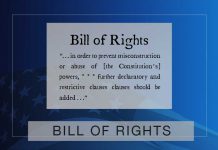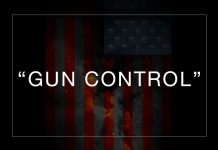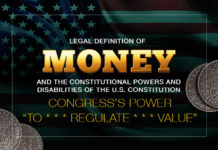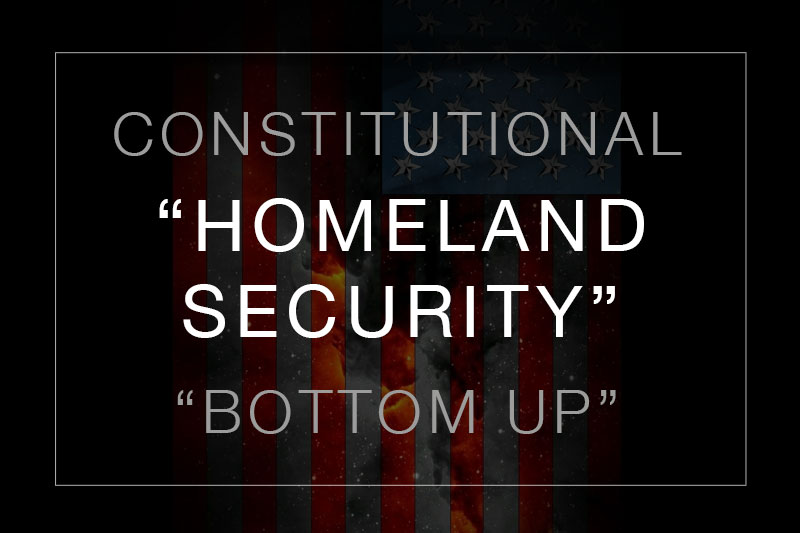Last Updated on October 5, 2021 by Constitutional Militia
The publication of National Security Presidential Directive 51 (Homeland Security Presidential Directive 20) on 9 May 2007, now available on the White House’s web site, represents another major stage in the devolution of the United States from a constitutional republic to a Caesaristic police state. Inadvertently, though, it exposes the primary danger to the continuation of its own power that the Establishment now fears. As well, it emphasizes the impossibility of any succor for the American people from the present “two” major political parties. And thus it should actually energize We the People into doing what is necessary to salvage freedom and prosperity in this country, before things get entirely out of hand.
(1) The unconstitutionality of NSPD-51 is blatant. NSPD-51 “establishes a comprehensive national policy on the continuity of Federal Government structures and operations * * * provides continuity requirements for all executive departments and agencies, and provides guidance for State, local, territorial, and tribal governments, and private sector organizations in order to ensure a comprehensive and integrated national continuity program that will enhance the credibility of our national security posture and enable a more rapid and effective response to and recovery from a national emergency” (paragraph (1).
To be sure, “executive departments and agencies” are parts of the Executive Branch of the General Government, in principle subject to the President. But other than the Treasury, which the Constitution itself requires (see Article I, Section 9, Clause 7), all “executive departments and agencies” are originally creatures of Congress, not the President. Therefore, their very existences, purposes, powers, personnel, and “continuity requirements” must be the products of statutes (“Laws,” as the Constitution generally terms them), not Presidential “directives” (for which the Constitution makes no provision whatsoever). Indeed, other than “Ambassadors, other public Ministers and Consuls, [and] Judges of the supreme Court,” the President may not constitutionally even “nominate, and by and with the Advice and Consent of the Senate * * * appoint” any “Officers of the United States” except those “which shall be established by Law,” or appoint any “inferior Officers” except those whose “Appointment” “Congress may by Law vest * * * in the President alone” (Article II, Section 2, Clause 2). That is, other than the President himself, the composition, structure, and operations of the Executive Branch are completely subject to the legislative supremacy of Congress.
As for maintaining appropriate “continuity” with respect to these matters, Congress enjoys ample— and exclusive—constitutional power to do whatever is needed. In general, “[a]ll legislative Powers” the Constitution “grant[s] shall be vested in * * * Congress”, not to any degree or for any purpose in the President (Article I, Section 1). And in particular, Congress alone is entitled “[t]o make all Laws which shall be necessary and proper for carrying into Execution” not only its own powers, but also “all other Powers vested by th[e] Constitution in the Government of the United States, or in any Department or Officer thereof”, including the powers of the President (Article I, Section 8, Clause 18). In this process, the President’s only forms of participation are: (i) to “recommend to [Congress’s] Consideration such Measures as he shall judge necessary and expedient” (Article I, Section 3); and (ii) either to “approve” “Bill[s] which shall have passed the House of Representatives and the Senate” or to “return [such] Bill[s], with his Objections” (Article I, Section 7, Clause 2). The President cannot himself enact “Laws.” Instead, he must “take Care that the Laws be faithfully executed” (Article II, Section 3).
Even if Congress has been remiss in not providing for the necessary and proper “continuity requirements” for “executive departments and agencies,” the President cannot on that account take unilateral action on his own initiative. America is not subject to “government by default.” In the absence of appropriate action by the constitutionally authorized Branch of government, the country does not find itself at the mercy of the self-appointed “leadership” of some other, unauthorized Branch of government. Any such “leadership” is not an act of “government” at all, but instead is usurpation at best, and a crime at worst (Title 18, United States Code, Sections 241 and 242). If the President honestly believes that this country needs “a comprehensive national policy on the continuity of Federal Government structures and operations,” he should present to Congress what he considers to be the “necessary and expedient” legislation for Congress to enact, and await Congress’s agreement with his assessment (Article II, Section 3).
Moreover, while the United States remains a federal republic and a free country, who is the President to provide “guidance for State, local, territorial, and tribal governments, and private sector organizations,” as NSPD-51 claims to do? Precisely where does the Constitution mandate to the President the role of universal teacher? Nowhere— because such an idea is positively un-American. For the most recent and ominous parallel, one must look to Mao Tse-tung, “The Great Helmsman” of Red China, whose “Mao Tse-tung Thought” appeared in the little red book countless millions of politically zombified Chinese Communists waved during mass demonstrations. Admittedly, the trip from America, even as corrupted as she is today, to something like Red China in the heyday of Mao Tse-tung is, no doubt, still a long one. But, as the Chinese aphorism has it, “a journey of a thousand li begins with a single step.” So, in humility and prudence, any President would do well to learn before he claims to teach, and therefore first to seek guidance from, rather than purport to impart it to, his fellow countrymen.
Not surprisingly, as the supposed source of its authority NSPD-51 employs an open-ended invocation of “emergency” conditions: “[c]atastrophic emergency means any incident, regardless of location, that results in extraordinary levels of mass casualties, damage, or disruption severely affecting the U.S. population, environment, economy, or government functions” (paragraph 2(a)). (One should notice how, as the break-up crisis approaches, the appeal to “emergency” alone no longer suffices, and politicians come to employ increasingly hysterical adjectives—today, “[c]atastrophic emergency;” tomorrow, perhaps, “apocalyptic emergency”—as if the degree of power to be seized depended only upon the draftsman’s facility with the dictionary, rather than upon his knowledge of the Constitution.)
As I have explained in previous commentaries, “emergency powers” are bunkum. The new twist in NSPD-51 is that some “[c]atastrophic emergency” supposedly could occur outside the United States, in some other country entirely. Or it could involve the failure of foreign banks, which “severely affect[ed] the U.S. * * * economy.” Or it could be a claimed consequence of supposed “global warming” or some other natural condition that might “severely affect[ ] the U.S. * * * environment.”
In virtue of these cataclysmic threats, NSPD-51 then asserts a breathtakingly unprecedented Presidential power: “[e]nduring constitutional government * * * means a cooperative effort among the executive, legislative, and judicial branches of the Federal Government, coordinated by the President, as a matter of comity with respect to the legislative and judicial branches and with proper respect for the constitutional separation of powers among the branches, to preserve the constitutional framework under which the Nation is governed and the capability of all three branches of government to execute constitutional responsibilities and provide for orderly succession, appropriate transition of leadership, and interoperability of the National Essential Functions during a catastrophic emergency” (paragraph 2(e)).
Needless to emphasize, NSPD-51 does not identify where and how the Constitution licenses the President to “coordinate[ ]” “cooperative effort[s] among the executive, legislative, and judicial branches of the Federal Government.” But the very claim to do so exposes the substance—or, perhaps more descriptively, the absence—of his “proper respect for the constitutional separation of powers.” For, if the President will himself “coordinate[ ]” these “cooperative effort[s],” presumably Congress and the Judiciary must accept, accede to, or acquiesce in his “coordinat[ion].” Certainly all three Branches cannot “coordinate[ ],” each in its own idiosyncratic manner. Neither can each of the three Branches go it own way and still “coordinate[ ]” with the others. One must lead, and the others follow.
NSPD-51 states that “[i]t is the policy of the United States to maintain a comprehensive and effective continuity capability composed of Continuity of Operations and Continuity of Government programs to ensure the preservation of our form of government under the Constitution and the continuing performance of National Essential Functions under all conditions” (paragraph 3). Yet it also provides that “[c]ontinuity requirements shall be incorporated into daily operations of all executive departments and agencies” only (paragraph 4). Of course, the verbal limitation to “executive departments and agencies” is necessitated by its being a Presidential “directive” which, even if constitutional, cannot apply to any other Branch of the General Government. But how, then, is “the policy of the United States to maintain a comprehensive and effective continuity capability composed of Continuity of Operations and Continuity of Government programs” to be achieved for Congress and the Judiciary? And how is “the preservation of our form of government under the Constitution and the continuing performance of National Essential Functions under all conditions” to be achieved without them? Or, in the minds of those who drafted NSPD-51, does only the Executive Branch count any more? What purpose will be served by preserving the “continuity” of the Executive Branch alone, while discontinuity or chaos grips the Legislative and Judicial Branches—except, perhaps, the purpose of creating the condition precedent for an overarching executive Decidership operating under some species of “martial law?”
Indeed, one need not be suffering from terminal paranoia to deduce exactly this intent from the assertion in NSPD-51 that “[t]he President shall lead the activities of the Federal Government for ensuring constitutional government” (paragraph 6). Not just “the activities of the Executive Branch,” but “the activities of the Federal Government” as a whole! Thus, “the separation of powers,” Congress’s power “[t]o make all Laws which shall be necessary and proper”, and the President’s own duty to “take Care that the Laws be faithfully executed” are submerged in das Fuhrer Prinzip (the Leader Principle). And every historically literate person knows where that has led in the past.
Most of the rest of NSPD-51 consists of a table of bureaucratic organization and duties that might form the kernel of a reasonable plan for maintaining the “continuity” of the Executive Branch—if submitted to Congress for incorporation into a “necessary and proper” law. Mandated directly by the President, however, it is usurpation. And if allowed to stand by Congress, it will mark a giant step in the systematic destruction of constitutional government in this country and its replacement by a brownshirted Caesarism.
(2) Caesarism of any color, though, is certainly not the primary fear of the people who drafted NSPD-51. The document lists a number of concerns:
The following [National Essential Functions] are the foundation for all continuity programs and capabilities * * * and therefore sustaining the following NEFs shall be the primary focus of the Federal Government leadership during and in the aftermath of an emergency that adversely affects the performance of Government Functions:
(a) Ensuring the continued functioning of our form of government under the Constitution, including the functioning of the three separate branches of government;
(b) Providing leadership visible to the Nation and the world and maintaining the trust and confidence of the American people;
(c) Defending the Constitution of the United States against all enemies, foreign and domestic, and preventing or interdicting attacks against the United States or its people, property, or interests; (d) Maintaining and fostering effective relationships with foreign nations;
(e) Protecting against threats to the homeland and bringing to justice perpetrators of crimes or attacks against the United States or its people, property, or interests;
(f) Providing rapid and effective response to and recovery from the domestic consequences of an attack or other incident;
(g) Protecting and stabilizing the Nation’s economy and ensuring public confidence in its financial systems; and
(h) Providing for critical Federal Government services that address the national health, safety, and welfare needs of the United States. (paragraph 5)
But surely no one can believe that the present Administration is interested, in the slightest degree,
- in “[e]nsuring the continued functioning of our form of government under the Constitution” — or it would not be promoting the North American Union;
- in “[d]efending the Constitution of the United States against all enemies, foreign and domestic”—or it would not be harboring Neo- Conzis and other dangerous subversives in public office;
- in “bringing to justice perpetrators of crimes or attacks against the United States or its people”—or it would not be demonizing patriots who justifiably find the official explanation of 9/11 as unsatisfactory as the official fable that Lee Harvey Oswald, acting alone, assassinated President Kennedy; or
- in “maintaining the trust and confidence of the American people”—or it would not be persisting in policies that have caused George W. Bush to be widely condemned as the worst President in American history (so far).
Similarly, no one can believe that the present Administration is interested, in the slightest degree, in “[m]aintaining and fostering effective relations with foreign nations”, when almost its every initiative in foreign policy is directed at denouncing, threatening, subverting, attacking, or occupying any nation that refuses to toe the globalistic line emanating from the Disgrace of Columbia.
So, too, can anyone expect a “rapid and effective response to and recovery from the domestic consequences of an attack or other incident” from the bureaucratic apparatus that orchestrated the fiasco in the aftermath of Hurricane Katrina?
And exactly how does the present Administration expect the General Government to “[p]rovid[e] for critical * * * services that address the national health, safety, and welfare needs of the United States” when, for instance, the Ponzi pyramid of Social Security finally collapses? For part 2 click below.




































